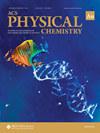Roundabout Mechanism of Ion–Molecule Nucleophilic Substitution Reactions
IF 3.7
Q2 CHEMISTRY, PHYSICAL
引用次数: 0
Abstract
Roundabout (RA) is an important indirect mechanism for gas-phase X– + CH3Y → XCH3 + Y– SN2 reactions at a high collision energy. It refers to the rotation of the CH3-group by half or multiple circles upon the collision of incoming nucleophiles before substitution takes place. The RA mechanism was first discovered in the Cl– + CH3I SN2 reaction to explain the energy transfer observed in crossed molecular beam imaging experiments in 2008. Since then, the RA mechanism and its variants have been observed not only in multiple C-centered SN2 reactions, but also in N-centered SN2 reactions, proton transfer reactions, and elimination reactions. This work reviewed recent studies on the RA mechanism and summarized the characteristics of RA mechanisms in terms of variant types, product energy partitioning, and product velocity scattering angle distribution. RA mechanisms usually happen at small impact parameters and tend to couple with other mechanisms at relatively low collision energy, and the available energy of roundabout trajectories is primarily partitioned to internal energy. Factors that affect the importance of the RA mechanism were analyzed, including the type of leaving group and nucleophile, collision energy, and microsolvation. A massive leaving group and relatively high collision energy are prerequisite for the occurrence of the roundabout mechanism. Interestingly, when reacting with CH3I, the importance of RA mechanisms follows an order of Cl– > HO– > F–, and such a nucleophile dependence was attributed to the difference in proton affinity and size of the nucleophile.离子分子亲核置换反应的迂回机制
迂回(RA)是气相 X- + CH3Y → XCH3 + Y- SN2 反应在高碰撞能量下的一种重要的间接机制。它是指在发生取代反应之前,CH3-基团在进入的亲核物碰撞时旋转半圈或多圈。RA 机制最早是在 Cl- + CH3I SN2 反应中发现的,用以解释 2008 年在交叉分子束成像实验中观察到的能量转移。此后,RA 机制及其变体不仅在多个以 C 为中心的 SN2 反应中被观察到,而且在以 N 为中心的 SN2 反应、质子转移反应和消除反应中也被观察到。本研究综述了近年来关于 RA 机制的研究,并从变体类型、产物能量分配和产物速度散射角分布等方面总结了 RA 机制的特点。RA 机制通常发生在较小的撞击参数下,并倾向于在相对较低的碰撞能量下与其他机制耦合,迂回轨迹的可用能量主要被分配为内能。分析了影响 RA 机制重要性的因素,包括离去基团和亲核物的类型、碰撞能量和微溶解。大量离去基团和相对较高的碰撞能量是发生迂回机制的先决条件。有趣的是,当与 CH3I 反应时,RA 机制的重要性按照 Cl- > HO- > F- 的顺序排列,这种亲核剂依赖性被归因于质子亲和力和亲核剂大小的差异。
本文章由计算机程序翻译,如有差异,请以英文原文为准。
求助全文
约1分钟内获得全文
求助全文
来源期刊
CiteScore
3.70
自引率
0.00%
发文量
0
期刊介绍:
ACS Physical Chemistry Au is an open access journal which publishes original fundamental and applied research on all aspects of physical chemistry. The journal publishes new and original experimental computational and theoretical research of interest to physical chemists biophysical chemists chemical physicists physicists material scientists and engineers. An essential criterion for acceptance is that the manuscript provides new physical insight or develops new tools and methods of general interest. Some major topical areas include:Molecules Clusters and Aerosols; Biophysics Biomaterials Liquids and Soft Matter; Energy Materials and Catalysis

 求助内容:
求助内容: 应助结果提醒方式:
应助结果提醒方式:


